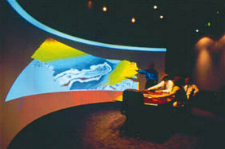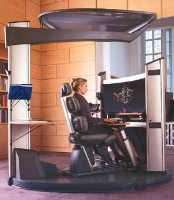What's happening in exploration
Visualization centers becoming the normContinuum Resources International recently hosted another collaborative demonstration in its 3-D visualization theater, this time between Houston and London. The demo went well, with panoramic 3-D displays and smoother motion than in previous attempts, as well as system voice commands that seemed more natural. To accomplish this, each collaborator had earlier obtained a common data set. Display attributes and voice are what was actually transmitted during the session. Although viewpoint may be shared / passed between participants, the system lacks a shared cursor – helpful when discussing visual data across the Atlantic. The company says it will include such a cursor in the future. The company is about to release its solution to displaying data across disparate application and hardware platforms. Named CoReExplorer, the system was created using the MuSE Development System. It allows software developers to create plug-in application modules of their new or existing software. The company will provide training, technical support and marketing coordination for third-party developers. Western Geophysical has joined the visualization fray by opening its VIEW (Virtual Immersive Environment Workroom) at its London office. It is the company’s first such center. Now that Continuum, Schlumberger, Veritas, Haliburton, Western Geophysical and Landmark all have visualization centers, the other big players will not be far behind. At a recent CGG press conference, the company hinted that it too might soon have a visualization center. In response to an editor’s question to CGG President Robert Brunck, "Is all this visualization really useful or mostly hype?" the response was an unequivocal, "It’s definitely useful."
If you’re not sure whether to invest in such systems, you can lease time at these centers from most of the companies listed above.
Visualization downsizing. The future of remote collaboration may not require immersive theaters but, instead, desktop, larger-screen viewers, such as the three-panel model displayed at Continuum’s SEG booth in November. If you’re spending too much time behind a computer, and can afford the $38,000 price, Smart Spaces Inc. unveiled the ultimate in comfort, functionality and ergonomic design for office computing. The rotating, closet-sized, curved-screen system offers everything imaginable in a computing environment: electronically adjustable and programmable leather chair, heating, filtered air, lighting, video teleconferencing and much more. Cluster computing. The University of Utah Center for High Performance Computing and the Utah Tomography and Modeling / Migration (UTAM) consortium are hosting a conference on cluster computing in Geophysics and the Sciences. The conference will be held at the Intermountain Network and Scientific Computation Center, February 3–4, 2000. The conference will apprise attendees of the current state of cluster computing in Geophysics and the Sciences, as well as some ideas of where cluster computing is headed. Speakers from the oil industry, computer industry, national labs and universities will share their experience and views in cluster computing. Included will be visits to several cluster computers at the University of Utah: a 20-SMP node, Pentium 450 MHz cluster devoted to 3-D migration and modeling in exploration geophysics; and a 108-node cluster devoted to scientific computation at the university. Topics include case studies, compilers (f77, f90, hpc, c++),
networking and a "cookbook" class on how to build your own cluster. For questions
contact: Julia Harrison at 801-581-5172 or julia@chpc.utah.edu.
Copyright © 2000 World
Oil |





